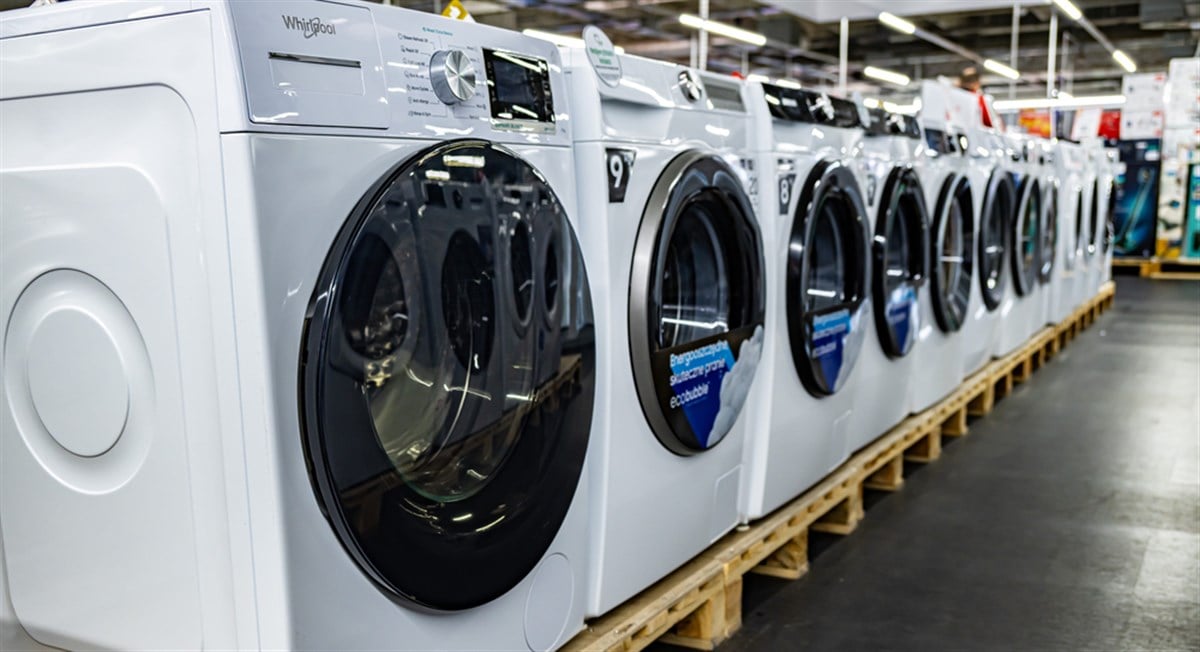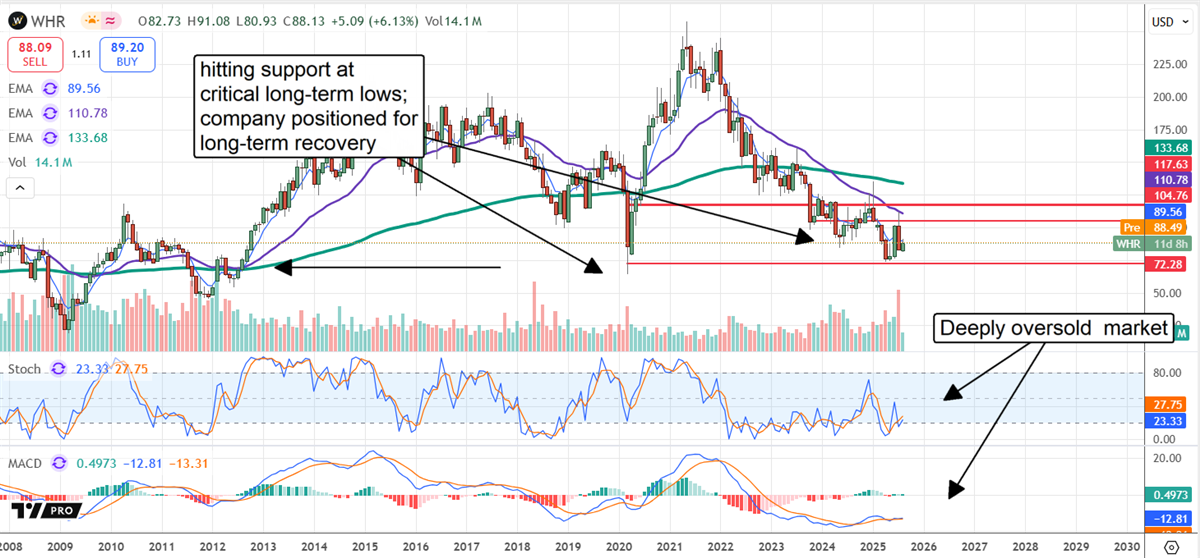
Key Points
- Whirlpool faces headwinds in 2025 but is well-positioned for a high-tariff environment long-term.
- The dividend cut was priced into the market; technicals reveal potential for a bottom and eventual price reversal.
- The short interest is rising quickly in 2025, but the institutions are buying, setting the market up for a squeeze, provided a catalyst emerges.
Whirlpool (NYSE: WHR) continues to face headwinds in 2025, including the near-term impact of tariffs, but the indications are that it is a screaming buy this year. The near-term effect of tariffs is declining revenue, weakening margins, and reduced guidance tied to competitors' imported merchandise stockpiling.
Whirlpool is a compelling buying opportunity because the market has already priced in its weaknesses, such as the upcoming dividend cut, and the long-term impact of tariffs is positive for this industrial stock.
Whirlpool’s manufacturing footprint is more than 80% domestic, which positions it well for the new trade environment, regardless of where tariffs stand when the negotiations are finalized. The long-term outlook also includes eventual recovery in the housing market, a dynamic that can sustain growth, margin, and cash flow for decades once begun.
The takeaway for investors is that Whirlpool’s stock price appears to be at or near its bottom, and the long-term outlook is robust, providing an attractive risk-reward scenario. In this scenario, Whirlpool’s stock price could fall to long-term lows in the mid-$60s but will likely rebound into the high-$100 to low-$200 range over time and pay its dividend.
Whirlpool: Dividend Cut Reflects Strategic Reset, Not Weakness
Whirlpool’s dividend cut isn’t a factor that investors like to see, but it aligns with the company’s best interests and long-term outlook for price appreciation. The dividend was reduced by more than 50% to an annualized $3.60, which puts the payout ratio at roughly 50% of the earnings forecast and under 100% of free cash flow.
Among the critical details is that WHR is still a high-yielding stock, paying about 4% in mid-August, and can sustain this for the foreseeable future. Once business recovery takes hold, the dividend could be increased, providing an incentive to the market.
MarketBeat’s analysts' sentiment data reveals trends that align with the market bottom. The post-Q2 release activity includes four revisions, many of which involve downgrades to Hold and equivalents and price target reductions.
However, the consensus remains at Hold, with new targets aligning with the 2025 price action, providing a floor for the market. That floor is supported by the institutions that own more than 90% of the stock collectively and have been buying on balance all year.
The balance of institutional activity is noteworthy because the group bought in every quarter this year through mid-August, including the post-release period, netting $3.50 in shares for each sold.
Risks Include Short-Sellers and the Balance Sheet
Whirlpool’s risks include the short-sellers and the balance sheet. The short-sellers have been piling into this stock and capping gains. The July data shows interest rising by 40% to hit a long-term high of 21% and will likely remain high in 2025.
The offsetting factor is the institutions, which are buying robustly and setting the market up for a squeeze/short-covering rally, provided a catalyst emerges.
Whirlpool’s balance sheet is healthy, but there are risks. The Q2 release highlighted reduced cash, increased inventory and total assets, offset by increased debt, total liability, and reduced equity.
The net result is that long-term debt leverage rose to 2.38x equity, a fortress-like quality, but it may continue to increase until the business recovery begins.
Whirlpool’s Chart Action Indicates a Bottom Is Near
Whirlpool’s 2022-2025 stock price decline is impressive, shedding nearly $200 or about 75%. The latest action has the market near long-term lows, which is significant because they align with the COVID-19 bottom and the onset of the 20212 housing market recovery, which is the likely bottom.
The potential for bottoming is evident in the summer 2025 rebound and volatility, characterized by increased volume and technical indicators that indicate bearish momentum has been played out, with oversold conditions prevailing across various time frames.
The price action may continue to move in a volatile fashion within the range, but a lower low is not expected.

Get Income-Generating Stocks Like Whirlpool in Your Inbox.
Stop riding the roller coaster of the stock market and sign-up to receive DividendStocks.com's daily ex-dividend stocks and dividend investing news for WHR and related companies.
Companies Mentioned in This Article:| Company | Current Price | Price Change | Dividend Yield | P/E Ratio | Consensus Rating | Consensus Price Target |
|---|
| Whirlpool (WHR) | $74.43 | +3.2% | 4.84% | -22.15 | Reduce | $86.43 |

About Thomas Hughes
Experience
Thomas Hughes has been a contributing writer for DividendStocks.com since 2019.
- Professional Background: Thomas Hughes is the Managing Partner of Passive Market Intelligence LLC, a market research platform he launched in 2023 with the mission: “We watch the market so you don't have to.” He has worked as a blogger, stock market commentator, and independent analyst since 2010 and has been actively involved in trading and investing since 2005.
- Credentials: He holds an Associate of Arts in Culinary Technology—training that honed his discipline, attention to detail, and ability to anticipate outcomes, all of which carry over into his work as a market analyst.
- Finance Experience: Thomas has been writing about finance and investing since 2011, when he discovered it could be more than a personal passion—it could be a profession. He’s been a contributing writer for DividendStocks.com since 2019.
- Writing Focus: He specializes in the S&P 500, small-cap stocks, dividend and high-yield strategies, consumer staples, retail, technology, oil, and cryptocurrencies. His analysis blends chart-based technical setups with key fundamental insights, helping readers identify actionable trends.
- Investment Approach: Thomas takes a hybrid approach that combines technical analysis with deep fundamental research. He often writes about macroeconomic shifts, earnings trends, and sentiment-based trading signals.
- Inspiration: Thomas first became interested in stocks after attending a seminar on how to buy and sell your own shares. That event opened his eyes to the market's potential and sparked a lifelong interest in investing.
- Fun Fact: Thomas took up model railroading by accident a few years ago—and now he can’t stop running the rails.
- Areas of Expertise: Technical and fundamental analysis, S&P 500, retail and consumer sectors, dividends, market trends
Education
Associate of Arts in Culinary Technology